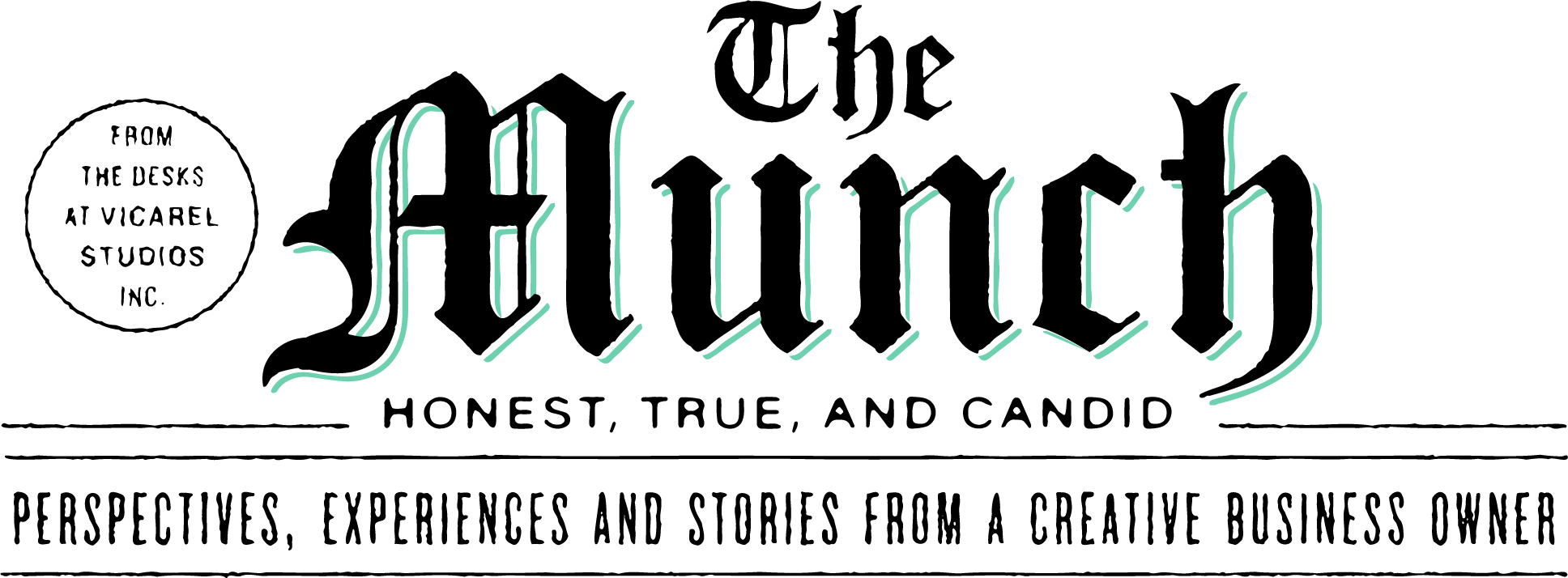The Guide to Graphic Design Pricing Methods: From Flat Rates to Slush Funds to Retainer Agreements.
Vol. 098
The Guide to Graphic Design Pricing Methods: From Flat Rates to Slush Funds to Retainer Agreements.
Maximizing profit and client satisfaction through strategic graphic design pricing methods.
If you’re a graphic designer or creative entrepreneur wondering how to charge for your services, you’re in the right place.
We’ve explored numerous pricing methods with countless clients. At first we just did Hourly or Project Rates, but our process and practice have continued to evolve. At this point, we truly understand challenges of pricing graphic design work, and want to share some insight.
Let’s talk about how to price graphic design work with a focus on the different pricing methods that we’re currently using.
Flat Rate Pricing (Project Pricing)
Let's start with graphic design flat rate pricing.
This is a common method where you propose a project cost based on deliverables. It is essential to consider the time and resources needed for the project to avoid accidentally undervaluing your work.
Flat Rate Pricing is great for designers who have a history of tracking time on their projects, understanding of how long something takes them (we use a free app called Toggl to track our time).
Pros to flat rate pricing or project pricing
The faster you complete the project, the better your hourly rate ends up being.
Your client knows exactly what they’ll get and exactly what it will cost.
Tracking time isn’t necessary (but you always should! It’s good reference for future projects)
Cons to flat rate pricing or project pricing
If the project takes much longer than expected, you’re still responsible for delivering based on the amount you agreed upon.
Scope creep can easily happen. If the scope of work changes, you must have methods in place to accommodate the additional work, whether that’s addendums to your contract, or maybe a slush fund agreement.
Retainer Agreements
Retainer agreements are an incredibly effective way to grow and sustain your graphic design business.
Retainers involve your client committing to a set amount of hours each month at an agreed upon rate.
A retainer is generally a “use it or lose it” model, meaning that if you agree to a 12 month retainer with 20hrs / month @ $75/hr ($1,500/month), and your client only gives you 15hrs of work in a particular month, they still must pay that full $1,500.
Retainers incentivize the clients to think ahead (because if they don’t, they’ll be paying you money for nothing!) which benefits you both. They’re able to get the most out of their dollar, and you, the graphic designer, experience less rush projects and surprises.
We set up our retainers with a 6 month minimum engagement.
When setting up a retainer agreement you will want to define the terms in a way that works for you:
How does your client request new or additional design work from you?
We use a project intake form to ensure we get all of the details efficiently.
When a project request is submitted, how quickly will you get to that project? Just because you have a retainer agreement setup doesn’t mean you need to drop everything else the moment a request is made.
How many hours will you work for this client each month?
What is the hourly rate for those hours?
What will weekly or monthly check-ins look like?
It’s important to have regular check-ins (we often do weekly) to discuss the status of projects, how many hours are left, and what is on the horizon.
What does billing look like for the retainer?
We normally bill at the end of every month.
Some businesses will offer discounted hourly rates based on the amount of hours the client commits to. For example, if a client hires you for 10hrs / month, your rate is $100/hr. If they hire you for 20hrs / month, your rate lowers to $90/hr. If you choose to offer a discount for additional hours, the amount you discount is up to you.
Retainer pricing is ideal for clients who require ongoing design work, and they’re a great way for graphic designers to establish a predictable income stream while also providing added value your clients.
By establishing a long-term relationship with a client through a retainer agreement, you can improve your cash flow and client satisfaction.
Pros of a retainer pricing model
You have a predictable amount of money and work coming in for a set period of time.
Retainers build trust. The long-term working relationship allows you to really get to know your client. You truly understand their pain points, their business, and you’re able to better support them.
Cons of a retainer pricing model
If you’re working a lot of hours for a particular client, you may begin to feel a bit like an in-house designer.
It’s not uncommon for you to become a “catch all” for anything design-related. This could be good, but it can become work that you may not enjoy. Be sure that your contract clearly defines what work you will and won’t do under this agreement.
If a new project pops up that demands a lot of your time, you are still obligated to fulfill any hours in your retainer.
Slush Fund Pricing Agreement
A slush fund functions kinda like a hybrid between a retainer and hourly pricing.
These agreements are good for a client who has ongoing, but intermittent work needs — a client with frequent lulls in their work needs might prefer a slush fund to a retainer model.
How a slush fund agreement works
A slush fund is a lump sum of money, paid in advance.
You have an agreed upon hourly rate, and any projects that your client requests (within the realm of stipulations set forth in your contract) can then be worked on against that lump sum amount.
Once the Slush Fund is near it’s end, you can notify your client, and re-up the slush fund, or terminate your agreement.
Slush Fund example:
If you have ongoing, but intermittent work with a particular client, you could setup a slush fund of $1,000 @ your hourly rate (let’s say $50/hr). This states that your client has paid for 20hrs of design work from you.
Whenever your client has a design need, they fill out a project intake form, and you then estimate the amount of hours needed to complete the project, and get their approval to move forward.
You then complete and deliver the work. At the end of every month, you inform your client how many hours are remaining in the slush fund.
We often setup a minimum hourly investment required per task assigned. For example, we will take on any tasks, but the minimum hourly requirement per task is 4hrs. So, if they want you to complete something that only takes 30 mins, they would still have to pay for 4hrs of work.
This clause is used to avoid becoming a catch-all for miserable, menial tasks that aren’t worth your time.
Pros of a slush fund pricing model
You don’t need to worry about back and forth project scoping, detailed estimating, additional contracts and project approvals. Slush funds get all of those details out of the way up front so you can focus on supporting your client efficiently and effectively.
Similar to a retainer, a Slush Fund agreement enables you to build up client repertoire as you support them for a longer period of time or engagement.
Cons of a slush fund pricing model
If you don’t clearly define timeline expectations (i.e., this is how far in advance you must request a project) you might find yourself with a lot of rush project requests. Avoid this through clearly defining your terms in your project intake form or slush fund contract!
If a task takes more than 4 hours, you are essentially trading hours for money. This is fine, but it doesn’t allow for as much potential profit margin as Flat Rate Project Pricing.
Rush Fee Pricing
Another way to keep control of your project, client and pricing process is through using rush fees.
Rush fees are an additional charge for urgent projects. It's important to communicate clearly with clients about rush fees and to have a clear policy in place to avoid misunderstandings.
Ultimately, rush fees benefit everyone.
The Client: Rush fees incentivize them to think ahead and plan more for their business.
The Designer: Rush fees reduce the amount of last minute project your client will request because they have to pay extra.
Even when using Slush Fund or Retainer Agreements, we have terms in our contract that define minimum lead times that must be met, otherwise we implement Rush Fees.
For example:
If we have a retainer agreement, we require a 3–5-day lead time on projects, meaning that we are not required to start working on a project for 3–5 days after receiving the project intake form. If a client needs something in a shorter period of time, we technically have the ability to implement a rush fee. In an effort to prove our partnership, we often will only implement the rush fee when it becomes a burdensome request.
There are numerous factors to consider when implementing Rush Fees (here’s some additional details on rush fees) but oftentimes they range between 50%–300% price increase, depending on the severity of the rush-request.
There's no one-size-fits-all approach when it comes to graphic design pricing methods.
As you grow your business, it's crucial to experiment with different methods and find what works best for you and your clients. Everyone is different.
We have found that the best graphic design pricing methods are:
Flat Rate Pricing (Project Pricing)
Retainer Agreements
Slush Funds
And, use Rush Fees when necessary.
The better you understand graphic design pricing and pricing methods, the more value and flexibility to your clients ensuring the long-term success of both of your businesses.
Hit us with any questions about pricing methods in the comments below, and let us know if you want us to create some retainer and slush fund agreement contracts for purchase!

